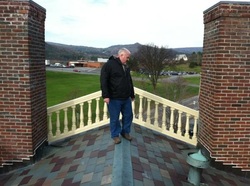
Assessing and prioritizing a building’s needs, planning for work, hiring and supervising contractors, and then maintaining the systems of the building in a good serviceable condition is part of a systematic process. The first step is a conditions assessment performed by an architectural historian or qualified historic preservationist. The systems of the building and causes of deterioration are identified, historically appropriate treatments are specified, the work is prioritized, and a construction budget is generated.
An added benefit of the conditions assessment is that much of the work needed later for the creation of a maintenance plan has already been performed. Sometimes a conditions assessment will include additional consultants such as structural engineers, MEP specialists, an architect or draftsman to create elevations and floor plans, and landscape architects. Depending on the level of detail and extent of work that goes into a conditions assessment, they vary from $5,000 to $50,000 or more.
It is important that the construction budget accurately reflect the real cost of the project as this is the time when funding will be pursued. Depending on sources of funding and other requirements, your project may require prevailing wages, bid, performance and payment bonds, excess liability insurance, and other specialized needs. It is critical that you know and understand what the different requirements are as each raises the cost of the job and may come with layers of paperwork and other requirements that will take time and money to complete.
The next step is to design and specify the work that is to be performed. In a large-scale project in which major building systems are being replaced wholesale or complete restoration is taking place, registered design professionals (architects and structural engineers) will create construction documents. In other instances, such as the replacement of roof flashing assemblies, the recommendations contained in the conditions assessment may be enough instruction. The cost of an architect’s design services will vary but may be expected to represent an additional 20% on top of the estimated project cost.
Requests for quotes (or bid packages) are then produced and advertised. Screening bidders and exercising due diligence is the next order of business. Learn more about screening and hiring the right contractor here. The contract is awarded, work commences and supervision begins. On larger jobs, this role is typically performed by yet another party who charges 3-5% of the total project cost. Acting as the clerk of the works, all aspects of project supervision are handled: construction management, change orders, billing, payment requisitions, and inspection of finished work. There is a reason why this is an actual occupation—building owners need to carefully assess their abilities if they chose to take on this role instead of hiring someone.
The final phase is the creation of a cyclical maintenance plan. The objective, after restoration and repair work is completed, is to keep and maintain all building systems in good serviceable condition. You can learn more about the creation of maintenance plans here.
It is important that the construction budget accurately reflect the real cost of the project as this is the time when funding will be pursued. Depending on sources of funding and other requirements, your project may require prevailing wages, bid, performance and payment bonds, excess liability insurance, and other specialized needs. It is critical that you know and understand what the different requirements are as each raises the cost of the job and may come with layers of paperwork and other requirements that will take time and money to complete.
The next step is to design and specify the work that is to be performed. In a large-scale project in which major building systems are being replaced wholesale or complete restoration is taking place, registered design professionals (architects and structural engineers) will create construction documents. In other instances, such as the replacement of roof flashing assemblies, the recommendations contained in the conditions assessment may be enough instruction. The cost of an architect’s design services will vary but may be expected to represent an additional 20% on top of the estimated project cost.
Requests for quotes (or bid packages) are then produced and advertised. Screening bidders and exercising due diligence is the next order of business. Learn more about screening and hiring the right contractor here. The contract is awarded, work commences and supervision begins. On larger jobs, this role is typically performed by yet another party who charges 3-5% of the total project cost. Acting as the clerk of the works, all aspects of project supervision are handled: construction management, change orders, billing, payment requisitions, and inspection of finished work. There is a reason why this is an actual occupation—building owners need to carefully assess their abilities if they chose to take on this role instead of hiring someone.
The final phase is the creation of a cyclical maintenance plan. The objective, after restoration and repair work is completed, is to keep and maintain all building systems in good serviceable condition. You can learn more about the creation of maintenance plans here.


